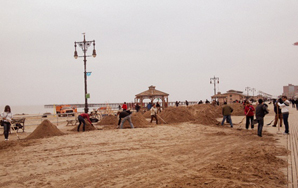14 Photos Of The Coney Island Boardwalk, 12 Days After Hurricane Sandy
The next day, we walked down to Coney Island to survey the damage and see how the recovery was progressing.

[youtube http://www.youtube.com/watch?v=XvJvHqhPeBc&w=584&h=390%5D
During the early evening of Monday, October 29, Hurricane Sandy reached Coney Island. With her, she brought a 14-foot storm surge, which drove the waves of the Atlantic Ocean over the sands of Coney Island Beach, over the wooden planks of the boardwalk, through the rides, games and attractions of the amusement parks, and onto Surf Avenue. By 7 PM, the streets were desolate. Just before 8 o’clock, power went out. At 9, seawater was covering cars.
Last Friday night, almost two weeks after the storm had passed, my girlfriend and I were visiting her mother in Gravesend, just across the creek from Coney Island. From the balcony of her 16th-floor apartment, you could make out the monolithic public housing buildings on the west side of Coney Island. They were engulfed in darkness, illuminated faintly by portable floodlights erected on odd street corners and the occasional red and blue flashes of emergency vehicles.

The next day, we walked down to Coney Island to survey the damage and see how the recovery was progressing. Going south on West 5th Street then west on Surf, we passed dozens of cars that had been damaged during the storm. Flood water had forced vehicles onto the sidewalks and, in a few cases, crushed them against trees and utility polls. If a window or windshield hadn’t been broken, condensation from water pooled inside the car collected on the glass, creating the impression of past lives. Many times, the owners had scribbled insurance information on the front or back windshield, which, in an odd way, made the vehicles resemble tombstones.

Though the Stillwell Avenue subway station had been open since last Wednesday, only a trickle of commuters were passing through and trash was strewn about. At one point, a man — possibly homeless, possibly just forlorn — walked up to us. He looked like he was about to say something, but then turned away and just lingered there. Throughout Coney Island, I feel like I saw more people silently standing around doing nothing than is common for New Yorkers. Even in groups, they stood there mum, looking too taxed to be pensive, motionless except to smoke their cigarettes.

National Guardsmen were deployed throughout Coney Island. Although they were there to assist with the recovery, the presence of humvees, military transport vehicles and fatigues produced the atmosphere of a warzone or the impending apocalypse. The feeling was compounded by the sporadic presence of electricity, which powered one traffic signal, then left the next three blocks powerless before perhaps picking up again.

Nathan’s was closed, along with the majority of local businesses. Although most stores were shuttered, the few that you could peer into revealed the degree of damage: dirt everywhere, inventory scattered on the floor, overturned tables, chairs, counters. Sometimes, they also revealed the owners, aggressively clearing away the refuse or simply gaping at their loss.


The amount of force with which the Atlantic came charging onto the streets of Coney Island became apparent while walking south on West 15th Street. Here, the beach began half a block before the boardwalk. The sand covering the asphalt rose slowly, but by the end of the street, the dune was high enough to bury the bottom half of a street sign.


Although much of the displaced sand from Coney Island Beach was driven between the concrete supports of the boardwalk (at points tearing open chain-link fencing), portions of the boardwalk itself were also covered. Volunteers with brooms and shovels were working to clear sediment from the boardwalk, collecting it in piles to be returned to the beach, which had lost so much sand that it was almost two feet lower than usual.

From the perimeter, there was no serious damage to the Wonder Wheel, the Cyclone and all of the other rides and attractions. I realize now that this was the only time I had experienced quiet on the boardwalk. The typical racket of carnival games, the roar of amusement park rides, the bellows of hawkers and prattle of pedestrians had vanished, replaced with a stillness so seemingly absolute that I don’t even recall hearing the lapping of the tide.

Coney Island Beach itself — never heralded for its pristine condition — was a patchwork of clear sand and piles of washed-up debris. Amongst driftwood were a few oddities: a row boat, a jet ski, an upholstered chair, a full-size refrigerator.




On one side of the beached refrigerator was an orange parks department truck being filled with trash to haul away. On the other side were two beachcombers, swaying their metal detectors around heaps of debris that would soon be trucked off to a dump. Though the woman claimed they hadn’t yet found anything, it was reassuring to see them there. If there ever was a testament to the resilience of humanity, it would be those two treasure hunters, looking for gold amidst the rubbish. ![]()


